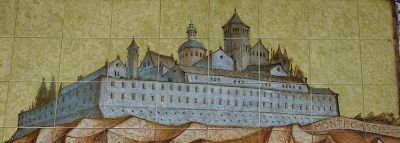Overlooking the ancient pre-Roman town of Casinum, now Cassino, the first Benedictine monastery sits atop a flat mountain ridge of the Central Apennines with spectacular views of the valleys below and the mountain ranges in the distance.
Casinum, about 75 miles southeast of Rome, was a fairly prosperous town built near the Via Latina, a major road to Rome constructed before Via Appia. Ruins of an amphitheater and other structures date the founding of the town to early 300 BC. During Roman rule, a temple to Apollo was placed on the mountain summit.
In 480 AD, Benedict, and by some accounts, a twin sister, Scholastica, were born in Norcia, now Nursia (a region of Umbria). In his teens, he was sent to attend school in Rome (about 60 miles southwest of Norcia), but after several years he decided on a quieter lifestyle. He traveled east to Subiaco, where he met Saint Romanus of Subiaco who encouraged Benedict to retreat in isolation to find inner peace, a movement that began in the Middle East in the third century. Saint Romanus provided spiritual advice, along with a monk’s habit, food and a place to live in a mountainside cave. Benedict took refuge in the cave for three years and as others heard of his strength in seeking solitude, they would seek his advice.
When the abbot of a nearby monastery died, Benedict was asked to take his place, but others opposed the offer and Benedict felt it was safer for him to leave Subiaco. In the mid-520s, he arrived in Cassino. Within five years, he established the Montecassino Abbey, replacing the Romans’ tribute to Apollo with the site dedicated to Saint John the Baptist.
A year later, Benedict developed the Benedictine Rule, the regulations for conduct in his monastery covering all aspects from the laws of governing to policies for disciplining monks and workers. Some topics in the 73 succinct chapters include the descriptions of four different types of monks, based on their experience and dedication; the requirements for an abbot; the obligation of both obedience and importance of community service; schedules for prayers, number of hours and specific psalms to recite each day, and the hours and types of food to eat at mealtime.
Spreading across northern Italy and the surrounding areas, now France, Switzerland, Austria, Germany, and Belgium, the Rule of Saint Benedict became the foundation for life in monasteries of Western Christianity.
The Order of Saint Benedict, founded in 1893 in Rome, oversees the independent Benedictine monasteries throughout the world that follow the Rule of Benedict. From the www.osb.org: “... hundreds of monasteries of monks and nuns come now under the Rule of Benedict. Simultaneously, the observance of these monasteries is unified, even in areas where the Rule left details to the discretion of the abbot.” Basic core values include Moderation, Stability, Respect, Dignity of Work, Listening, Stewardship and Justice.
Benedict died in the mid-540s. Around 25 years later, Montecassino was destroyed, as was much of Rome, by the Lombards. A second monastery was built in the early 700s, but it was destroyed when the Saracens invaded parts of the Italian peninsula in the mid-800s. The monks returned to Montecassino in the late 10th century and it prospered until the end of the 12th century. Over the centuries, the monastery was seized or abandoned numerous times. In the mid-14th century, it was destroyed by an earthquake, and it was severely damaged during WWII. Rebuilt after the war, the monastery received greater recognition when in 1947, Pope Pius XII appointed Saint Benedict the Father of Europe. In 1964, the rebuilt basilica was sanctified by Pope Paul VI and Saint Benedict was named a Patron Saint of Europe.
It is noted that Saint Benedict founded at least 12 other monasteries southeast of Rome, one being the Abbey of Saint Scholastica in Subiaco, named after his sister, a nun of the Benediction Order. Saint Scholastica, a patron saint of education, founded the women’s branch.
Not too far from the Abbey of Saint Scholastica, the cave of Benedict’s three-year retreat is a sacred site. In the late 11th century, a sanctuary, Lower Church, was built into the mountain, surrounding the bare rock interior of the cave where Benedict lived. Two hundred years later, the Upper Church was added. Both were constructed by the monks who lived in the monastery. Passages lead to chapels adorned with decorative mosaic panels and elaborate frescoes depicting the life of Saint Benedict and other religious figures, including the earliest known portrait of Saint Francis of Assisi.



